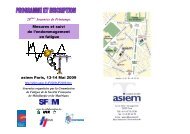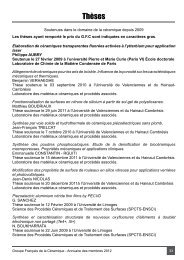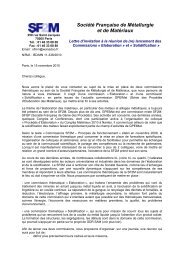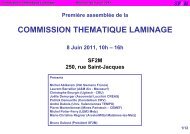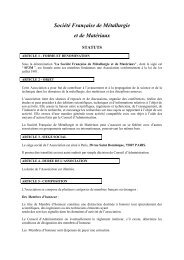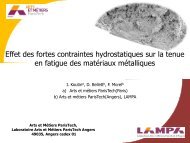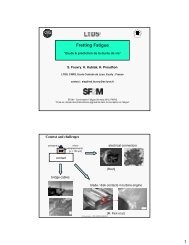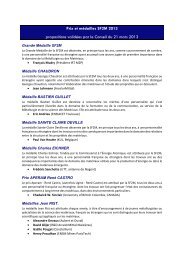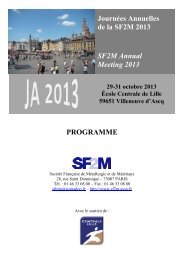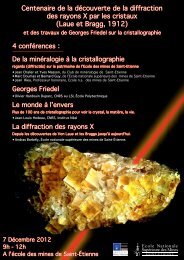PROPOSITION DE SUJET DE THESE 2012/2015 AU ... - SF2M
PROPOSITION DE SUJET DE THESE 2012/2015 AU ... - SF2M
PROPOSITION DE SUJET DE THESE 2012/2015 AU ... - SF2M
You also want an ePaper? Increase the reach of your titles
YUMPU automatically turns print PDFs into web optimized ePapers that Google loves.
<strong>PROPOSITION</strong> <strong>DE</strong> <strong>SUJET</strong> <strong>DE</strong> <strong>THESE</strong> <strong>2012</strong>/<strong>2015</strong><br />
<strong>AU</strong> CENTRE <strong>DE</strong>S MATERI<strong>AU</strong>X<br />
<strong>DE</strong> L’ECOLE <strong>DE</strong>S MINES <strong>DE</strong> PARIS<br />
TITRE :<br />
en français : Nouvelles architectures de surfaces d’échange : application aux<br />
composants multicouches avancés pour l’amélioration de l’efficacité<br />
énergétique (électrodes de pile à combustible, électrolyseurs…)<br />
en anglais : New architecture of multi-layered advanced components for<br />
the enhancement of energy efficiency (electrodes for fuel cell,<br />
electrolyser…)<br />
Mots clés :<br />
en français : multimatériaux, interfaces, surfaces d’échange, performance, bas<br />
coût de fabrication, électrodes interdigitées<br />
en anglais : multimaterials, interfaces, exchange surfaces, performances,<br />
low manufacturing cost, interdigitating electrodes<br />
Directeur(s) de thèse : Anthony CHESN<strong>AU</strong>D (chercheur, Mines ParisTech),<br />
Alain THOREL (directeur de recherche, Mines ParisTech)<br />
En français :<br />
Présentation détaillée<br />
Comme dans la plupart des filières technologiques (batteries, échangeurs<br />
thermiques, supports de catalyse, piles à combustible, électrolyseurs,<br />
électronique de puissance, capteurs et filtres électrochimiques, membranes de<br />
séparation, pompes à gaz…) développant des systèmes muticouches<br />
(multimatériaux), la surface d’échange est un paramètre essentiel pour<br />
garantir l’efficacité énergétique. A l’échelle microscopique d’un matériau, la<br />
zone par laquelle les échanges et les interactions s’établissent (joint de grains<br />
et interfaces hétérophases) influence fortement les processus physiques et<br />
chimiques qui régissent les propriétés mascrospiques du composant, et donc<br />
ses performances. Il est ainsi naturel de se poser la question de savoir s’il est<br />
possible d’améliorer les propriétés physiques des multimatériaux par<br />
déploiement de leurs surfaces d’échange à une échelle proche de celle de la<br />
microstructure, de quelques nanomètres ou quelques micromètres, et ce par<br />
des techniques bon marché (coulage en bande, sérigraphie, frittage laser<br />
sélectif, …) pour s’efforcer d’abaisser les coûts de fabrication tout en<br />
augmentant sensiblement les performances.<br />
Les piles à combustible (PaC -HT) et les électrolyseurs (EvHT) sont des<br />
exemples de systèmes multicouches (électrode/électrolyte/électrode) dont la
commercialisation est fortement retardée, en raison d’une stabilité physicochimique,<br />
électrochimique et mécanique encore insuffisante des systèmes et<br />
d’un coût de fabrication trop élevé en regard des performances. Un<br />
abaissement des températures de fonctionnement tout en maintenant le<br />
niveau de performances permettrait de répondre à ces deux impératifs. Une<br />
diminution de l’épaisseur de l’électrolyte, dans une configuration anodesupport,<br />
ou bien l’usage d’un matériau « de substitution » présentant des<br />
performances équivalentes, voire même supérieures, le changement du mode<br />
de conduction ou la mise en œuvre d’un autre concept de pile à combustible,<br />
sont des stratégies expérimentées par l’équipe, et qui visent entre autres à<br />
abaisser la température de fonctionnement visant à améliorer la durabilité de<br />
ces dispositifs tout en augmentant leurs performances.<br />
Une autre stratégie, qui peut d’ailleurs être avantageusement couplée aux<br />
précédentes, permettant d’atteindre ce même objectif, repose sur l’usage de<br />
matériaux d’électrode présentant une faible résistance spécifique surfacique,<br />
nommé ASR (Area Specif ic Resistance). De ce paramètre dépendent deux<br />
effets : (i) la surtension d’activation, qui peut être minimisée par activation des<br />
processus de transfert de charge aux interfaces électrode/électrolyte, pour<br />
ainsi augmenter les courants d’échange i o limitants à faible courant de<br />
polarisation ; (ii) les surtensions de concentration qui peuvent se réduire en<br />
améliorant le transfert des espèces gazeuses vers les sites électroactifs des<br />
électrodes, et ainsi augmenter les courants de saturations i cs (cathode) et i as<br />
(anode), limitants à fort courant de polarisation.<br />
Ces considérations impliquent la nécessité de développer un matériau<br />
d’électrode à architecture (nature et surface d’échange de l’interface<br />
électrode/électrolyte) et microstructure (fraction volumique , taille et<br />
morphologie [tortuosité, percolation] du réseau poreux) optimisées afin<br />
d’abaisser la température de fonctionnement sans perte de performances.<br />
Des bicouches électrode/électrolyte (LSM/YSZ) standard s d’une pile à<br />
combustible de type SOFC, planes, rugueuses ou interdigitées, seront<br />
susceptibles de constituer un premier terrain d’étude. Ces recherches<br />
s’accompagneront du développement et de l’optimisation des procédés de<br />
mise en forme des matériaux et d’assemblage, avec pour objectif une<br />
diminution des coûts de fabrication de la cellule. Il s’agira de relier les<br />
procédés de fabrication, ainsi que les caractéristiques des interfaces<br />
obtenues, aux performances électrochimiques des dispositifs. Des<br />
modélisations morphologiques et électrochimiques étayeront le cycle<br />
d’optimisation architectural et microstructural en s’appuyant sur les résultats<br />
de mesures électriques. Cette étude enrichira l’équipe d’accueil et le centre de<br />
connaissances académiques et techniques sur les surfaces d’échanges et leur<br />
contrôle ; cette démarche sera sans nul doute applicable à d’autres systèmes<br />
étudiés au centre (accrochage et adhésion, tribologie, échangeurs thermiques,<br />
composants pour l’électronique de puissance et la mécatronique, voire aux<br />
biomatériaux pour la compatibilité et la colonisation osseuse). Le sujet de<br />
thèse fait suite à un brevet déposé par le Centre des Matériaux, dans le cadre<br />
du projet I<strong>DE</strong>AL-Cell, sur l’optimisation architectural de composants<br />
électroactifs.<br />
----------------------------------------------------------------------------------------------------------
Le Centre des Matériaux situé à Evry (35 km au sud de Paris) est un<br />
laboratoire associé au CNRS (UMR 7633) emploie environ 181 personnes<br />
dont 38 enseignants-chercheurs, 38 ITA, 82 doctorants et 10 post-doctorants.<br />
Les recherches concernent l’élaboration, la caractérisation microstructurale,<br />
les études expérimentales du comportement des matériaux, la modélisation et<br />
la simulation numérique. Elles sont réalisées en étroite collaboration<br />
contractuelle avec des partenaires industriels.<br />
In english:<br />
Detailed presentation<br />
For most of innovative technologies (batteries, heat exchangers, catalyst<br />
supports, fuel cells, electrolysers, power electronics, electrochemical sensors<br />
and filters, separation membranes, gas pumps…) developing multi-layered<br />
systems (multi -materials), the exchange surface is a key factor to guarantee<br />
energy efficiency. On a microscopic scale of the material, the area through<br />
which the exchanges and interactions establishe (grain boundaries and<br />
heterophase interfaces) strongly impacts the physical and chemical processes<br />
that govern the macroscopic properties of component, and hence its<br />
performance. Thus, the question is whether it is possible to improve physical<br />
properties of multi-materials by deploying their exchange surfaces on a scale<br />
similar to that of the microstructure, from few nanometers to several<br />
micrometers. In order to reach this objective, cheap technologies (tape casting,<br />
screen printing, selective laser sintering, ...) will be implemented with the<br />
intention of lowering manufacturing costs.<br />
High temperature fuel cells ( SOFC, PCFC, I<strong>DE</strong>AL-Cell) and electrolysers<br />
(HTE) are examples of multi-layered systems (electrode/electrolyte/electrode)<br />
the marketing of which is strongly delayed owing to still insufficient physicochemical,<br />
mechanical and electrochemical stabilities and too high<br />
manufacturing costs, with respect to performances. Lowering operating<br />
temperatures while maintaining a high level of performances would fulfil both<br />
requirements. A decrease in the electrolyte thickness, in a supported anode<br />
configuration, or/and the use of new materials exhibiting equivalent or even<br />
better performances, the change in conduction mechanism or developing<br />
innovative concepts, are strategies tested out by the team which aim, among<br />
others, at lowering the operating temperature to improve durability of the<br />
electrochemical devices, while maintaining or even increasing the level of<br />
performances. Another strategy, which can also be advantageously coupled<br />
with the preceding ones and allowing to achieve the same objective, is based<br />
on the use of electrode materials with low area specific resistance (ASR). This<br />
latter parameter is driven by two effects: (i) the activation overpotential, which<br />
can be minimised by activation of the charge transfer processes at<br />
electrode/electrolyte interfaces, thereby increasing the exchange current i o that<br />
is limited at low bias current; (ii) the concentration overpotential that can be<br />
reduced by improving the transfer of gaseous species towards electroactive<br />
sites, thus by increasing the saturation currents i cs and i as on the cathode and<br />
anode side respectively, both being limited at high bias current.<br />
These considerations imply the need to develop electrode materials with<br />
optimised architectures (nature and exchange surface at the
electrode/electrolyte interface) and microstructures (volume fraction, size and<br />
morphology [tortuosity, percolation] of the porous network) in order to lower the<br />
operating temperature while maintaining a high level of performances. The<br />
implementation of flat, rough or interdigitated electrode/electrolyte interfaces of<br />
a LSM/YSZ bilayer may constitute a first work to explore such a subject. This<br />
investigation will be carried out in parallel with the development and<br />
optimization of shaping processes of component and assembly, with the aim of<br />
lowering fabrication costs. It will be important to connect manufacturing<br />
processes and characteristics of the interfaces obtained with the<br />
electrochemical performances. Morphological and electrochemical modelling<br />
will support the microstructural and architectural optimisation cycle based on<br />
results of the electrical measurements. This study will enrich the skills of the<br />
team and the center with academic and technical knowledge on exchange<br />
surfaces and their monitoring; this approach will undoubtedly be applicable to<br />
other systems which are being studied in the center (treatment before coating<br />
and adhesion, tribology, heat exchangers, components for power electronics<br />
and mechatronics, or biomaterials for compatibility and bone colonization). The<br />
subject pursues a patent for improvement filed by the Centre des Matériaux<br />
within the framework of the I<strong>DE</strong>AL-Cell project and dealing with architectural<br />
optimisation of electroactive components.<br />
----------------------------------------------------------------------------------------------------------<br />
The Centre des Matériaux located in Evry (35 km south of Paris) is a<br />
laboratory associated with the CNRS, employing around 181 people including<br />
38 researchers, 38 technicians, 82 PhD students and 10 Post-Doctoral<br />
researchers. Research concerns materials processing and surface<br />
modification, the microstructural characterisation and experimental study of the<br />
behaviour of materials. These studies are carried out in close contractual<br />
collaboration with industrial partners.<br />
Résultats attendus : -<br />
Méthode : -<br />
Conditions restrictives sur les candidatures :<br />
Financement doctorant :<br />
Expérience souhaitée / profil : sciences des matériaux, chimie du solide,<br />
céramiste<br />
Relations contractuelles : aucune<br />
Références bibliographiques/References : -
Le dossier de candidature comportant :<br />
- un curriculum vitae détaillé ;<br />
- une lettre de motivation ;<br />
- relevés de notes ;<br />
- lettres de recommandations et les noms, les coordonnées d’au moins<br />
deux personnes pouvant être contactées pour recommandation ;<br />
est à faire parvenir au Centre des Matériaux de l’Ecole des Mines de Paris, BP<br />
87 – 91003 Evry Cedex à l’attention du Service recrutement ou par mail à :<br />
recrutement@mat.ensmp.fr<br />
NB : seules les candidatures adressées par courrier au service de<br />
recrutement ou par mail à recrutement@mat.ensmp.fr seront prises en<br />
compte.<br />
Applicants should supply the following:<br />
- a detailed resume;<br />
- a covering letter explaining the applicant’s motivation for the position;<br />
- detailed exam results;<br />
- two references: the name and contact details of at least two people who<br />
could be contacted to provide an appreciation of the candidate;<br />
to be sent to Centre des Matériaux de l’Ecole des Mines de Paris, BP 87 –<br />
91003 Evry Cedex, to the attention of recruitment department, and/or by e-<br />
mail: recrutement@mat.ensmp.fr<br />
NB: only those candidates who address a letter to the recruitment<br />
service, or an E-mail to recrutement@mat.ensmp.fr, will be considered.



